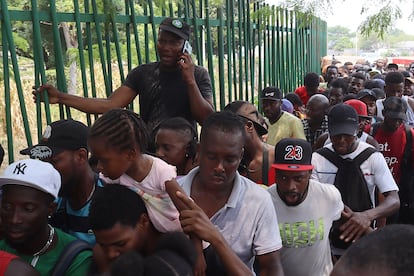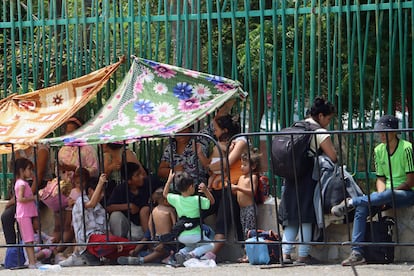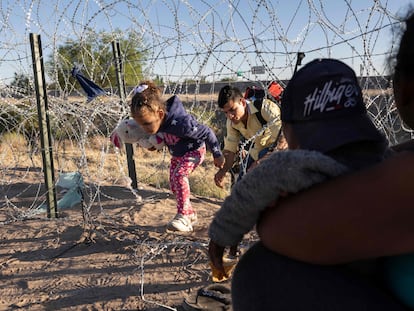‘There’s no more room here!’: Thousands of migrants rush to Mexico’s southern border as Title 42 nears end
The city of Tapachula has become a bottleneck where those seeking to travel north are stuck for months as they wait for a temporary permit that will allow them to continue their journey to the U.S.

It’s nighttime in Tapachula and a crowd of migrants is pushing into one of the entrances to the offices of the National Institute of Migration (INAMI), in the suburbs of the city. Two National Guard offices guarding the entrance use all their effort to stop the metal fence erected to hold back the migrants from being pushed down. Behind the fence, some 2,000 migrants huddle together, waiting their turn. But others rush forward, while the officers try to stop them. “Enough already,” one agent yells. Amidst the chaos, a group of Venezuelan migrants take pity on the officers and help them hold up the fence to stop the flow.
The officers gather themselves. “There’s no room for more here! We can’t fit anymore!” one of the officers yells, exasperated, to the immigration agents trying to control the migrants behind the fence.
For the past two weeks, thousands of migrants have been lining up every day in miles-long queues in front of the migration offices in Tapachula, the main entrance into the southern border of Mexico. They are waiting in line to request a temporary permit from the Mexican government that will allow them to legally advance towards the Mexico-U.S. border. Most of them are hoping to cross into the United States before the imminent end of Title 42, a pandemic-era rule of the Trump administration that denies asylum on grounds of preventing the spread of Covid-19.

Migrants from Venezuela, Haiti, Central America and even Africa have been waiting hours and days for their turn. They are desperate. On Monday, they endured the relentless sun as the temperature rose to 35ºC (95ºF). In the afternoon, it rained down on them.
News that Title 42 is set to end on May 11 has caused a crisis on the U.S.-Mexico border, where the U.S. government has stationed 1,500 soldiers to reinforce security and prevent the passage of tens of thousands of migrants. Some 2,174 miles (3,500 kilometers) further south, on the Mexico-Guatemala border, another crisis is playing out.
The thousands of migrants who manage to reach Mexican soil are piling up as they wait for a permit to be able to legally transit to the north. However, others have decided not to wait and are continuing their journey north without the permit, taking alternative routes where they are unlikely to be detained by immigration officers and deported. But these routes come with other risks: robbery, kidnapping, extortion and even death.
But waiting for the paperwork is also a painful process. “Brother, I have been lining up here for four days. I am not going to move an inch,” says a 37-year-old Venezuelan, as he waits in the rain next to his wife.

The crisis on the Mexico-Guatemala border is not new. Human rights organizations working on the ground estimate that there are between 40,000 and 50,000 migrants trapped in Tapachula, the main entrance on Mexico’s southern border. Many of them have come here seeking to apply for a humanitarian visa or refugee status, but have been forced to return or wait for months due to the slow-moving bureaucracy.
On April 23, a caravan of about 3,000 migrants left Tapachula for Mexico City. The leader of the caravan, Irineo Mujica, an activist with the organization Pueblo Sin Fronteras (People Without Borders), reached an agreement with the Mexican government: in exchange for breaking up the caravan, migrants would be offered a 45-day temporary permit.
In Tapachula, Mexico’s National Immigration Institute opened a mobile office in the city’s Ecological Park and began granting express permits to hundreds and then thousands of migrants. According to local newspapers, authorities are handing out more than 1,000 permits per day. But despite this, the line seems to go on forever. Migrants in Tapachula say that the immigration officers are working until 2am to clear the site. But by mid-morning the next day, the line is growing again.
Although the National Immigration Institute is issuing temporary permits non-stop, it does not have the capacity to address the rising number of migrants who have arrived in the past few weeks. The chaos and the lack of organization from authorities means that many migrants are spending days waiting in line in the harsh weather and sleeping in the surrounding streets.

Mexico’s National Institute of Information reported on Tuesday that between November 23, 2022, and May 6, 2023, Mexico issued 81,245 temporary permits to people from 103 countries on the five continents. Many migrants come from countries previously almost unheard of in Mexico such as Kyrgyzstan, Burkina Faso, Djibouti, Estonia, Eritrea, Sri Lanka and Réunion Island. The countries with the highest number of applicants are Venezuela, Ecuador, Haiti, Honduras and Angola.
No one knows what will happen after Thursday, when Title 42 comes to an end. However, the crisis continues to worsen on both Mexico’s northern and southern border. “This is not going to end. More and more people are coming behind us. They say that the United States is going to open the doors and all we want is for them to let us through,” says Óscar, a young Honduran who has been stuck in Tapachula for three months and has spent three days waiting for the permit that will allow him to move towards his destiny: the north.
Sign up for our weekly newsletter to get more English-language news coverage from EL PAÍS USA Edition
Tu suscripción se está usando en otro dispositivo
¿Quieres añadir otro usuario a tu suscripción?
Si continúas leyendo en este dispositivo, no se podrá leer en el otro.
FlechaTu suscripción se está usando en otro dispositivo y solo puedes acceder a EL PAÍS desde un dispositivo a la vez.
Si quieres compartir tu cuenta, cambia tu suscripción a la modalidad Premium, así podrás añadir otro usuario. Cada uno accederá con su propia cuenta de email, lo que os permitirá personalizar vuestra experiencia en EL PAÍS.
¿Tienes una suscripción de empresa? Accede aquí para contratar más cuentas.
En el caso de no saber quién está usando tu cuenta, te recomendamos cambiar tu contraseña aquí.
Si decides continuar compartiendo tu cuenta, este mensaje se mostrará en tu dispositivo y en el de la otra persona que está usando tu cuenta de forma indefinida, afectando a tu experiencia de lectura. Puedes consultar aquí los términos y condiciones de la suscripción digital.
More information
Archived In
Últimas noticias
Most viewed
- Sinaloa Cartel war is taking its toll on Los Chapitos
- Oona Chaplin: ‘I told James Cameron that I was living in a treehouse and starting a permaculture project with a friend’
- Reinhard Genzel, Nobel laureate in physics: ‘One-minute videos will never give you the truth’
- Why the price of coffee has skyrocketed: from Brazilian plantations to specialty coffee houses
- Silver prices are going crazy: This is what’s fueling the rally










































